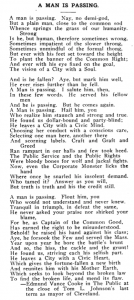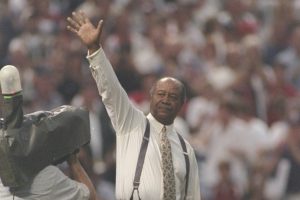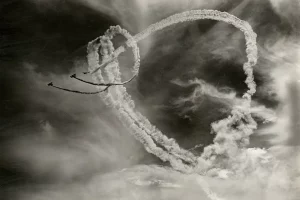A man is passing: Ode to Tom L Johnson by Edmund Vance Cooke (1912)

www.teachingcleveland.org
A man is passing: Ode to Tom L Johnson by Edmund Vance Cooke (1912)


11 weeks after Jackie Robinson’s debut, Larry Doby arrived
By Frederic J. Frommer/Washington Post July 5, 2022
Team owner Bill Veeck recalled receiving 20,000 letters after signing Doby, “most of them in violent and sometimes obscene protest. Over a period of time I answered all. In each answer, I included a paragraph congratulating them on being wise enough to have chosen parents so obviously to their liking.” “Signing Doby was Veeck’s first defining moment as a major league owner,” wrote Paul Dickson in “Bill Veeck: Baseball’s Greatest Maverick.” The move “gave him a voice as a progressive and social critic.”
The link is here

Will Cleveland Ever Develop Its Lakefront?
New Plans Are a Step Closer The pieces coming together for a bold, new vision for the lakefront.
by Ken Prendergast – Cleveland Magazine August 2022
The link is here

The Story of Cleveland’s 1st Neighborhood (video)
In this episode of the History and the Stories of our Neighborhoods, we will tell the story of Cleveland’s first neighborhood, which is the Flats and the Warehouse District – some of the most popular neighborhoods in which to visit when in town. The rich history of the city, starts here, and as we celebrate Cleveland’s 225th birthday of it’s founding, this is a great way to tell the story of such a prominent place in the city’s history.
Join Nishani Frazier, an Associate Professor of History and American Studies at the University of Kansas for a webinar on the civil rights movement in Cleveland.
In conjunction with the Cleveland Civil Rights Trail, Frazier will cover the long arch of political activism among Black Clevelanders from around the city’s founding to the modern civil rights era, and document how this rich history relates to the present day. Come celebrate Black History Month by learning about the history of Civil Rights in Cleveland. This program is made possible in part by Ohio Humanities, a state affiliate of the National Endowment for the Humanities.
Any views, findings, conclusions, or recommendations expressed in this publication/ exhibition/program/website do not necessarily reflect those of the National Endowment for the Humanities.
Visit https://clevelandcivilrightstrail.org/ to learn more about the Cleveland Civil Rights Trail.
On the shores of Lake Erie lies the old world remnants of a city we now call Cleveland. Let’s go back in time and take a look at what this area has to offer..
From Old World Exploration

CLEVELAND, Ohio — They were big, bold, and visionary. And they never made it from blueprint to reality.
Since the late 1980s, planners, developers, and civic organizations have come up with at least nine big plans for developing the downtown lakefront, including proposals about how to better connect downtown to Lake Erie. Yet downtown is still firmly separated from the water by the Ohio 2 Shoreway and rail lines used by Norfolk-Southern and the Greater Cleveland Regional Transit Authority.
Here’s a list of the lakefront proposals, and what happened to them:
– The city’s 1988 Civic Vision 2000 Downtown Plan included Progressive Corp.’s proposal to build a lakefront skyscraper headquarters designed by architect Frank Gehry that would have risen next to an extension of the downtown Mall overlooking North Coast Harbor. Progressive dropped the idea and built its headquarters in suburban Mayfield.
(Related coverage: Could downtown Cleveland’s parks and public spaces be more fun and better programmed? A new survey seeks answers)

– A new downtown plan called “Civic Vision 2000 and Beyond’’ grew out of a closed-door process in 1997-98 led by executives of Cleveland Tomorrow, representing the city’s top corporate leaders. The plan included a concept for linking downtown more strongly to the lakefront. After a big rollout, it never gained momentum.

– In 2001, Cleveland Tomorrow and the Growth Association, then the city’s chamber of commerce, followed up with a concept called “The Shoreway: Reclaiming Our Lakefront’’ that aimed at revamping the lakefront highway to foster development between downtown and the lakefront. The proposal was the first to take a serious look at the issue.
– In 2004, the city completed its Waterfront District Plan, the biggest lakefront vision in 50 years. It was led by then-city planning director Chris Ronayne, working under former mayor Jane Campbell. (Ronayne is now the Democratic candidate for Cuyahoga County executive.) The plan called for extending the Mall over the Shoreway in a manner that anticipated a proposal like the 2021 Haslam proposal.

– A 2009 plan developed under then-mayor Frank Jackson, led by waterfront planner Stanton Eckstut, called for extensive redevelopment of lakefront land owned by the city and the Port of Cleveland, with new blocks oriented diagonally to deflect prevailing winds. A 2012 update included a spot for a pedestrian bridge from the Mall to North Coast Harbor.

– The 2010 Cleveland Design Competition, conceived by local architects, challenged contestants to figure out how to use a multi-modal transportation hub as a connector between downtown and the lakefront. Entries by more than two-dozen teams came from around the world. The ideas were visionary but failed to motivate action.

– In 2013, expanding on ideas from the Eckstut proposal in 2009, Cleveland developer Dick Pace and Texas-based developer Trammell Crow proposed widening the East Ninth Street bridge over the Shoreway with a parklike expansion and building a Mall extension slightly to the east of the one later proposed by the Haslams. The city didn’t approve of the idea, Pace said.

– In 2014-2016, the non-profit Group Plan Commission proposed an eye-catching, $25 million pedestrian bridge designed by Boston architect Miguel Rosales, to connect the Mall to the Rock Hall. After the estimated construction cost rose, the city rejected the concept as impractical and too expensive.

– A 2019 concept developed by the nonprofit Green Ribbon Coalition proposed extending the Mall as a wide “land bridge’’ oriented northeast toward North Coast Harbor. The concept stirred public interest, but the city stayed mum on it until Jackson said in 2021 that he liked the Haslam proposal, which he described as a “land bridge.”

Eliot Ness is a 20th-century law enforcement legend. Most people know him as the incorruptible crime fighter who brought down Chicago gangster Al “Scarface” Capone during Prohibition in the early 1930s. Ness was immortalized in a book, television series and movie — all titled “The Untouchables.”
His name graces the atrium of the U.S. Justice Department’s Bureau of Alcohol, Tobacco, Firearms and Explosives (ATF) headquarters in Washington, D.C. Ness is so ingrained in American culture that, curiously, there’s even a craft beer named after him: Eliot Ness Amber Lager out of Cleveland. The Ness legend is largely fiction, however. He was never an FBI agent, as many people believed; he worked for the Bureau of Prohibition, the forerunner of the ATF tasked with stopping the sale and consumption of alcohol between 1920 and 1933. Ness also rarely carried a gun.
“Eliot Ness was involved in trying to disrupt the flow of beer and look for evidence of bootlegging but never found enough evidence to build a strong case against Capone on those charges,” Jonathan Eig, the author of “Get Capone: The Secret Plot That Captured America’s Most Wanted Gangster,” told me. Instead, Capone was sent to prison for tax evasion. “Ness was one of the smaller players, to be honest, in building the case against Capone.” But a story about the Internal Revenue Service accountants who gathered evidence against Capone would be pretty boring, he notes.
An upcoming festival in Coudersport, Pa., is doing its part to reconcile Ness the larger-than-life lawman and the real-life federal agent with integrity who still serves as a role model. One part of his legend is true: Ness and his team did earn the nickname “The Untouchables” because they couldn’t be bribed, unlike many other contemporaries.
The Eliot Ness Fest, scheduled for July 15-17, acknowledges the entertaining Hollywood fiction while putting Ness’s achievements in historical context. Thousands are expected to converge on the small Pennsylvania town this summer for a three-day event celebrating Ness’s career. The Eliot Ness Fest is also a family-friendly tribute to law enforcement, wrapped up in Roaring Twenties cosplay.
Stephen A. Green, an organizer of the event who’s the president and CEO of the Eliot Ness Museum, calls it “an opportunity to relive one of the most glamorous and violent periods of the country’s past.” It includes films, a parade and historical enactments. The festival this year coincides with the 50th anniversary of ATF; Associate Deputy Director and Chief Operating Officer Thomas Chittum will deliver the keynote address.
In addition to Chicago, Ness is associated with Cleveland, where he served as the city’s public safety director in the 1930s and ’40s. Ness lived in Coudersport only for about the last year of his life. But Coudersport is the birthplace of Ness’s “Untouchable” legend.
Ness moved to the scenic town in north-central Pennsylvania with his third wife and their 10-year-old son to pursue a business opportunity. Before he died of a heart attack in 1957 at age 54, Ness met with writer Oscar Fraley multiple times at the Hotel Crittenden, located in the center of town just across the street from where the Eliot Ness Museum now stands. They talked about Ness’s crime-fighting days and made plans to write a book about his experiences.
The lawman had resisted sharing his story, but he was deeply in debt and needed the money the book would bring in, says A. Brad Schwartz, the co-author with Max Allan Collins of “Scarface and the Untouchable: Al Capone, Eliot Ness, and the Battle for Chicago” and “Eliot Ness and the Mad Butcher: Hunting America’s Deadliest Unidentified Serial Killer at the Dawn of Modern Criminology.”
Ness didn’t approve of the exaggerations in Fraley’s draft, but he’s nevertheless credited as a co-author of the resulting book when it was published shortly after his death. These days, many people who know his backstory agree that “The Untouchables” is a highly embellished tale of Ness’s part in bringing Capone to justice.
The book spawned a television series starring Robert Stack that ran from 1959 to 1963 and the 1987 movie starring Kevin Costner. The book, series and movie cemented Ness’s image as a tough-talking, gun-toting federal agent, much to the annoyance of some who knew the true story of Capone’s downfall.
“There were plenty of people who were still alive who remembered the real history and knew Eliot Ness had nothing to do with it,” Schwartz told me. Getting Capone was a team effort by the Prohibition Bureau, the Treasury Department and the Bureau of Investigation, the agency that became the FBI, he explains.
“What’s been lost in the fight is all of the work he did to modernize, to professionalize and to reform law enforcement,” Schwartz says. Ness’s work on the Capone case was ahead of its time in trying to make law enforcement less brutal and corrupt. It also laid the foundation for the Racketeer Influenced and Corrupt Organizations Act to prosecute organized-crime figures.
Ness didn’t resurface in the media again until 2014, when three U.S. senators proposed naming the ATF headquarters in D.C. after Ness. But the Chicago City Council passed a resolution introduced by city Alderman Edward M. Burke protesting the move, which revived the debate over what Ness did and didn’t do in the Capone case. Ultimately, ATF named its headquarters after Ariel Rios, the first ATF agent killed in the line of duty after the ATF became an independent bureau. (Burke was indicted on federal racketeering and bribery charges in 2019 and is awaiting trial.)
In recent years, ATF has been instrumental in setting the record straight on its most famous agent and celebrating his achievements. The bureau named the atrium after Ness when the building opened in 2008. A portrait of Ness created from a collage of ATF agents’ photos is on display. “Clearly, there’s a mythology that’s built around Eliot Ness,” acknowledges ATF’s Chittum. “That’s not lost on any of us.”
Chittum told me he jumped at the chance to speak at this year’s Eliot Ness Fest. The man and the myth serve an important storytelling function that allows the bureau to highlight bigger issues, he says. “Ness is also a symbol of ethical law enforcement. In an era where there are a lot of questions about the legitimacy and credibility of law enforcement, I think it’s worth celebrating the honest cop.”
Samantha Drake is a freelance writer in Doylestown, Pa.
Tour the tunnels below Cleveland’s Soldiers’ and Sailors’ Monument
by Jean-Marie Papoi
May 3, 2022

